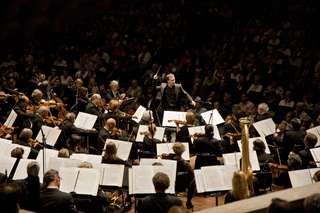|
Back
Dancing on the Dais New York
Avery Fisher Hall, Lincoln Centre
08/04/2009 - & August 5
Igor Stravinsky : Pulcinella (Complete ballet music)
Wolfgang Amadeus Mozart: Piano Concerto No. 20 in D Minor, K. 466
Felix Mendelssohn: Symphony No. 4 in A Major (“Italian”), op. 90
Karen Cargill (Mezzo-soprano), Toby Spence (Tenor), Matthew Rose (Bass), Nicholas Angelich (Piano)
Mostly Mozart Festival Orchestra, Yannick Nézet-Séguin (Conductor)

Y. Nézet-Séguin (with Rotterdam Philharmonic) (© Marco Borggreve)
The musical buzz for Yannick Nézet-Séguin, making his New York debut, was so great that one anticipated a gigantic presence in front of the Mostly Mozart Festival Orchestra. His initial appearance, though, was quite the opposite. Out danced a diminutive figure (even smaller next to bass Matthew Rose), who leaped upon the dais and proceeded to dance, jump, and play some electrifying pirouettes with his arms and shoulders in front of his ensemble.
Those movements are hardly uncommon with younger conductors, cueing in each instrument. An orchestra producing what the conductor works so hard to accomplish is rarer. But Maestro Nézet-Séguin knew his orchestra, was generous with his soloists, and in this most interesting concert, he accomplished far more than his idiosyncratic gymnastics would have initially promised.
The French-Canadian, who recently replaced Valery Gergiev at the Rotterdam Philharmonic, offered a program of well-known works. Yet that only made it more challenging. Those expecting another Pulcinella Suite would have been delighted, though, to hear these quaint songs with little Russian touches. The Mozart 20th Concerto is correctly popular, and Mendelssohn’s “Italian”……well, the young Felix has been heard to death this bicentennial of his birth.
Mr. Nézet-Séguin had a singular advantage in the Stravinsky: three soloists whose own vocal flamboyance almost matched the movements of the conductor. Toby Spence wowed us last week with Britten’s Serenade, with a tenor which was never held back, but had a clarity and stentorian effect. The Scots soprano Karen Cargill, is equally outward, equally dramatic (albeit swooping up to those high notes with fire-engine loudness). Finally, Matthew Rose never buried that bass range at all.
The trio were so well suited to each other, and Mr. Nézet-Séguin operated the orchestra with such efficiency, that one never thought of the ballet or the controversy over Pergolesi. The first half was played like a late Baroque orchestra with voices. The second half was more Stravinsky, but the piece simply swung into shape with some extremely sharp orchestral coloring and rococo-style vocalizing.
Nicholas Angelich, the soloist in Mozart’s dramatic 20th Concerto, showed a right poetic sensitivity in all three movements, with a very limpid middle section. Surprising to this listener were his idiosyncratic cadenzas in both movements, which I surmised he had composed himself. Not, it was Ludwig van Beethoven who took on those mighty cadenzas, which were not quite in sync with Mozart’s more subtle emotions.
That was music for the soloist. But how would the showy Mr. Nézet-Séguin handle Mendelssohn? He was still enormous fun to watch, but in the middle two movements, the orchestra sounded pallid, as if they weren’t terribly interested. Obviously that had to change for the Saltarello Presto finale, where Mr. Nézet-Séguin made the Mainly Mozart Festival Orchestra strings work their arms off.
That was par for the course. What kept Lincoln Centre shaking, though, was the first movement. Allegro vivace, but Mr. Nézet-Séguin gave it a tempo a whole lot faster than presto. It was so fast, in fact, that one often lost contact with the strings, and one had to listen to the woodwinds–absolutely marvelous here–to know where we were in the music.
As a tour de force, it didn’t work. But Mr. Nézet-Séguin is young enough to try everything. It was obvious that the orchestra enjoyed him. He, in turn, asking virtually all the sections for individual bows, enjoyed making music with this splendid ensemble. And we, growing accustomed to his pace, should have infectiously enjoyed the entire evening.
Harry Rolnick
|